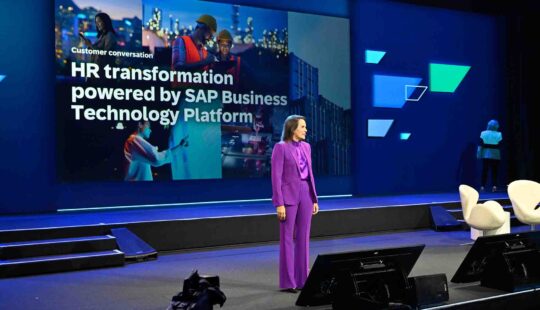I’m often intrigued by the assumption that new business initiatives require trade-offs. While it’s true that initial discomfort nearly always appears in the pursuit of growth, embracing new perspectives and skills can ultimately lead to better work and more strategic outcomes when executed effectively.
The concept of working in cross-functional, self-managed teams – or what we call “dynamic teams” – is a reality for most employees. In our SAP SuccessFactors global study, we found well over three-fourths (82%) of respondents have participated in a dynamic team more than once, and 64% are engaged in multiple dynamic teams simultaneously.
Despite being created out of necessity, dynamic teams can be either a culture shift or a culture shock. Our research shows that fewer than one-quarter (20%) of employees are satisfied with these experiences and only 36% of managers are motivated to encourage direct reports to participate in a dynamic team in the future. Surveyed managers want clear expectations for their employees’ involvement, real-time updates on challenges and progress, and awareness of skills acquired through the dynamic team experience.
According to Kathi Enderes, Ph.D., senior vice president of Research and global industry analyst at The Josh Bersin Company, the HR technology used often contributes to this misalignment within dynamic teams. “People don’t naturally work in a linear structure. However, teams often fall into the trap of following the rigid hierarchies of their traditional HR technologies, stemming from the industrial age, to manage performance, give feedback, coach, and develop teams,” says Enderes.
Heed the Signs of a Changing HR Landscape
The informality of dynamic teams can provide the flexibility companies need, but it can also lead to trouble for the overall business culture. It’s human nature to lean into the convenience of casually asking people we already know and like to join a dynamic team to tackle a critical business issue or deliver a strategic initiative. But that also means managers are missing out on talented people without the right connections – narrowing the diversity of knowledge, critical capabilities, and compatible traits necessary to deliver positive outcomes.
Management decision-making about personnel based on a biased “who knows who” mindset – rather than a strategically focused one – can limit employee opportunity and reduce engagement, and highly skilled employees suffer. They increasingly disengage when passed over for roles and promotions that can further develop their competencies. The people with the potential, desire, and enthusiasm to acquire and apply new skills who are shut out of any chance to grow eventually seek out a new employer openly committed to their immediate and long-term personal development.
That kind of environment is the perfect breeding ground for groupthink. Over time, entrenched teams are compelled to add more tasks, processes, systems, and complexity rather than subtracting existing ones that do not add value to the project at hand.
C-suite leaders can – and must – find ways to eliminate this risk in their workforce culture. By prioritizing digital strategies for properly skilling and engaging employees and matching them to the right opportunities, they set a foundation that not only creates a future-ready workforce but also future-proofs the business.
As a first step, organizations need to start their HR transformation journey with an understanding of the skills available today and the skills that will be needed in the future. This includes keeping a dynamic team strategy adaptable enough to support a growing list of diverse work arrangements, including hybrid work, the four-day work week, talent marketplaces, internal gig work, or non-linear career pathways.
“People now work in agile teams that come together around customer problems, analyze and solve them, and disband again quickly,” says Enderes. “HR technologies must be as dynamic as the way we work today.”
Enhance Outcomes with Greater Organizational Agility
Cohesive and cross-functional team strategies that support organizational agility unlock the door to dynamic teams that are not only successful but also embody the benefits of empowerment and inclusiveness. With visibility into their existing workforce, organizational managers can construct teams that reflect the diversity of the people impacted by the initiative’s outcomes. Even more, they connect the right people to the right challenges, elevating the quality of the workforce by creating more skilled employees.
The first step is forming a team-based structure – a shared visual representation of the team – to define individual roles and help ensure accountability. In return, dynamic team leaders and their members can pinpoint gaps in skills, functions, and responsibilities and source new colleagues with the skills and strengths that can add value to the overall initiative.
Colleagues across different departments can discover open dynamic team roles through the SAP SuccessFactors Opportunity Marketplace solution. Leaders can quickly generate an assignment within the dynamic team experience that includes the role description and required skills and qualifications. As soon as the assignment is published, employees throughout the organization can view the open role, consider if they or someone else is a fit, and apply if interested – all from the same view.
The opportunity for organizational managers and business leaders to measure team progress among cross-functional teams with objectives and key results (OKRs) is a significant advantage. Until now, this insight was shrouded in manual reporting and simplistic dashboards, limiting transparency and a complete understanding of how their people – whether seen or unseen – contribute to the business when working in teams. Yet, more importantly, this capability enables individual talent to build on skills and interests enriched by their experience and thinking.
“Integrating dynamic teams functionality with HR technology allows employees to work on multiple projects and help accomplish critical goals,” says Enderes. “With team management capabilities, the ability to source team members through SAP SuccessFactors Opportunity Marketplace, and an OKR experience integrated with talent management, performance management across cross-functional teams and individual contributors is made possible. It supports the ‘now’ and the future of work.”
This approach allows executives, managers, and employees to become more aware of what efforts and contributions are critical to the business. Employees can connect their team-based OKRs to their individual performance goals in the SAP SuccessFactors Performance & Goals solution by tying team performance to established business metrics. They can spend their time working on projects they understand are critical for the business and their personal development and growth – all with the confidence that leaders will appropriately recognize their contributions.
The benefits go even further, as organizational leaders build dynamic teams across departmental boundaries with visibility into the volume and composition of successful dynamic teams and OKR data to track team progress and outcomes. Leaders can create report stories with the SAP SuccessFactors People Analytics solution to tap into cross-functional knowledge and foster a culture that confidently achieves program goals and is consistently prepared for new challenges and opportunities.
Embrace a More Dynamic Future of Work Now
Being among a network of people who appreciate and value each other’s work, strengths, and potential can be a very motivating aspect of everyone’s employee experience. It’s what drives people – of all roles and backgrounds – to seize opportunities to develop their skills, contribute more to the business, and establish themselves as highly desirable talent.
This energy across the workforce can become pivotal in how the business grows and succeeds in the long run. Organizations often have a better chance of achieving their goals by building dynamic teams with a mix of internal and external experts. Yet, at the same time, talented professionals can develop new skills and practice existing ones within the safety of a supportive environment.
One thing is true: a business transformation in which dynamic teams are a centerpiece requires transparency and data-driven insights. Together, these two ingredients can optimize dynamic team composition, experiences, and outcomes.
Interested in learning how your investment in SAP SuccessFactors solutions can help you optimize the outcomes of your increasingly fluid workforce? View the infographic and watch the video about our dynamic teams functionality.
Meg Bear is president and chief product officer at SAP SuccessFactors.



